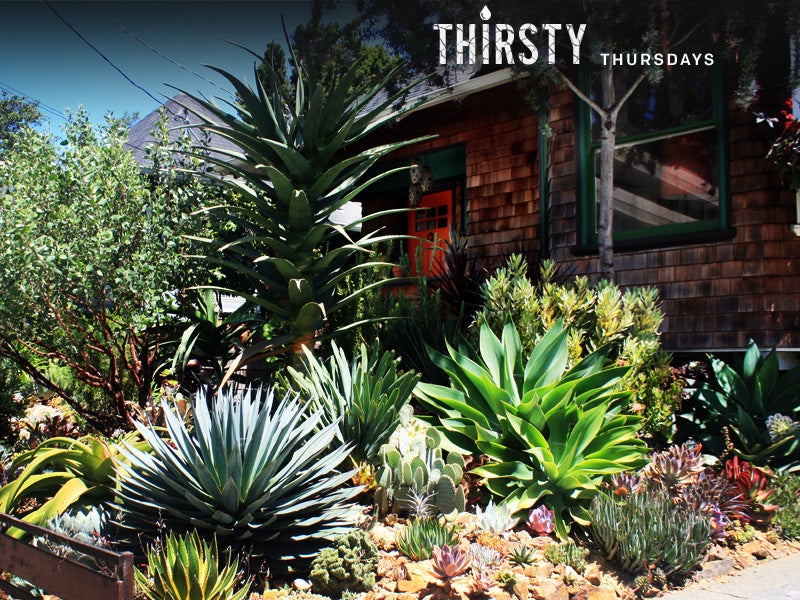Succulents and Wildflowers Leave Water-Wasting Lawns in the Dust
Houses in the California Bay Area are sporting dramatic displays of low-water plants that entice native bees and keep homeowners from pouring money down the drain.

This page was published 10 years ago. Find the latest on Earthjustice’s work.
Hundreds of hardy succulents morph into Seuss-ian shapes like the leggy “Irish rose,” the appetizing “blue curls” and the bulbous “living rock.” Mark Anthony Ramirez’s yard is arguably the best looking in his Oakland, California neighborhood, and he’s not growing a single blade of grass.
“There used to be a lawn here,” Ramirez says, “but I wanted more texture, form and variation.” After using stacked layers of cardboard, compost and mulch—called sheet mulching—to kill the parched grass, Ramirez transplanted his diverse collection of potted succulents into a mix of soil, pumice and lava rock. He says he now waters as little as twice a month in sunnier times and never in the winter.
California is mired in a years-long drought, and lush lawns with wasteful sprinkler systems are coming under fire. Governor Jerry Brown has called on Californians to rip out 50 million square feet, or about two square miles, of lawn and replace it with drought-tolerant plants fed by drip irrigation.
Many water districts offer cash rebates of $1 to $3 per square foot to homeowners who ditch their lawns. By one estimate, replacing grass with low-water plants and a drip system of rubber tubing means a family can cut outdoor water use by more than 90 percent. That means a much lower water bill, though it can cost about $3 per square foot for the initial makeover.
Kathy Brenzel, garden editor for Sunset magazine and editor of the new “Western Garden Book of Easy-Care Plantings” says she’s been swamped with people asking how to rescue their yards from the drought. Summer isn’t the right time to do major landscaping because all plants—even succulents—need more water to get established. But Brenzel says to plan ahead for fall and think about features you’d like: meadow grasses and flowers, garden boxes or maybe an assortment of shrubs like “Little Miss Sunshine.”
Putting succulents and native plants around your home not only saves precious water, but it also creates more habitat for bees and other pollinators, including 1,600 California native bee species. The University of California, Berkeley Urban Bee Lab offers a helpful guide to native and exotic plants that bees love.
Some species of North American native bumblebee have declined by more than 95 percent, alongside a massive increase in the use of insecticides called neonicotinoids, which are applied to seeds and spread through the body of plants as they grow. Research suggests these chemicals are pushing bees to the brink of extinction, and Earthjustice is working to curtail their use, along with the use of other pesticides like 2,4-D and chlorpyrifos that are toxic to humans. You can help by minimizing the use of insecticides and never spraying them on open flowers.
“To avoid pesticides, choose the right plants,” Brenzel advises. Pests don’t bother drought-tolerant plants as often, and Brenzel says if you make your garden inviting to predators like birds they’ll do the bug-catching for you. She and Elana Chavez, a landscaper in Redwood City, recommend fragrant plants like lavender, yarrow, salvias, and California lilac to entice pollinators like hummingbirds and bees (not to mention human visitors).
Chavez, who specializes in organic, edible plants points out that many veggies, including potato, squash and eggplant, are drought-tolerant and practical. Put straw or mulch around them to help keep water from running off or evaporating. Going a step further, use plastic buckets to catch water in your shower as it warms up to let the otherwise wasted resource nourish your garden.
Earthjustice supports efforts to cut personal water use while we also fight for larger scale conservation. The goal is to keep the spider web of Delta canals and the San Francisco Bay healthy so these ecosystems can support threatened wildlife like Chinook salmon while also providing clean drinking water not just now but for generations. The Western U.S. is in the midst of a severe drought and everyone—farmers, industry and individuals—has to use less of the water we have left. Where better to start than outside your front door?
About this series
Thirsty Thursdays is a weekly blog series exploring the historic drought in the western United States. In the ongoing series, we’ll share expert opinions, breaking news, compelling articles and the work Earthjustice is doing to protect water resources in a time of extreme water scarcity.
Don’t miss last week’s post:“California’s Drive for Deeper Water Leaves State on Shaky Ground.”